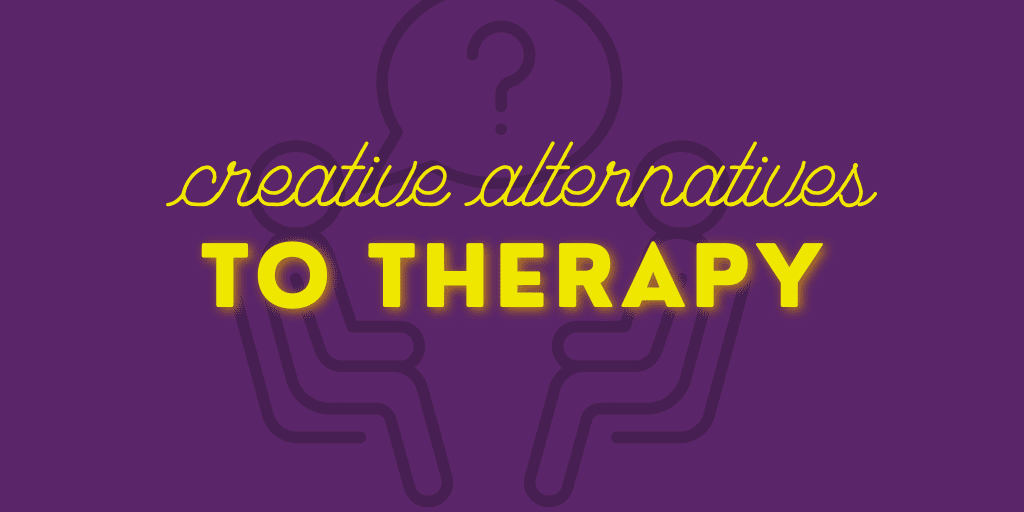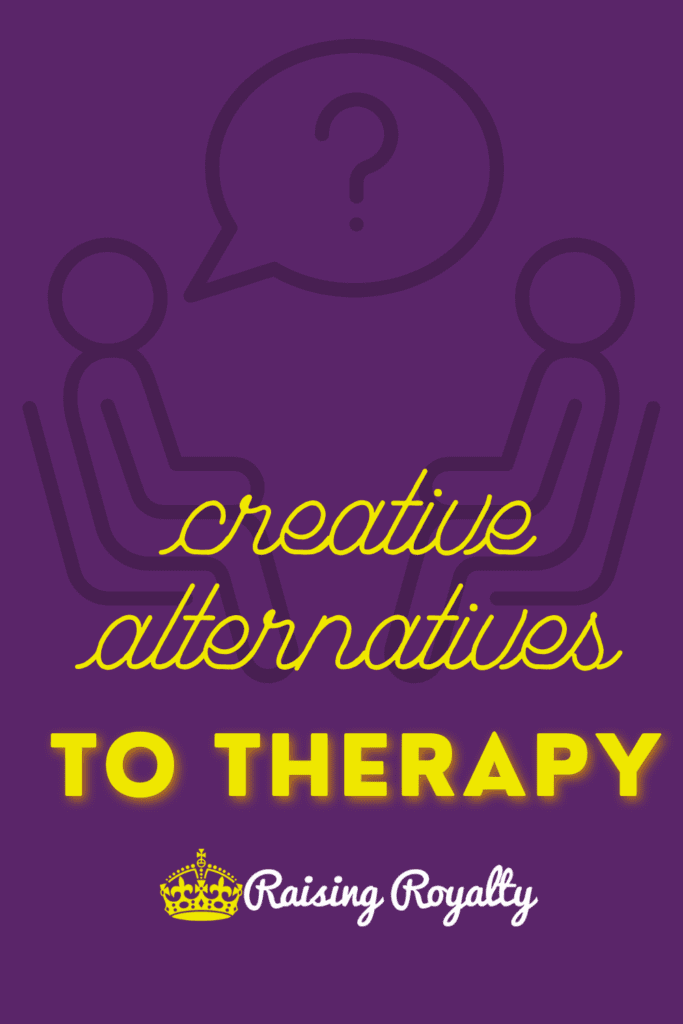

If you’ve ever thought your child could use a little extra help, you’ve probably looked into therapy of some kind. Parents with special needs kids, or of kids with injuries, or even just a child struggling with a normal developmental challenge all experience the same thing: therapy is expensive. And if you don’t have private insurance (even in Canada, where I live), few families can afford very many sessions. So we need to look for creative alternatives to therapy.
There are 5 types of therapies.
Most often, when you discuss therapy, people tend to think of talk therapy or behavioural therapy, that benefits emotional and mental wellness. But there are 4 other types of therapy: speech and language therapy, occupational therapy, physical therapy, and relationship therapy. For the purposes of this blog post, we’ll look at just 4: OT, PT, SLT & behavioural therapy.
Physical Therapy
Physical therapy supports development and proper use of gross motor muscles. So this covers things like movement, balance, posture, strength, reaction and hand-eye coordination. Most people will use physical therapy when they are recovering from an injury, such as a broken bone, but PT can be used for a lot of other issues, such as strokes, scoliosis, and many other diseases.
Traditional physiotherapy
Traditional PT will cover many specific exercises with a physical therapist , such as stretching, weight training, and aerobics. Physiotherapists will tailor the exercise to target specific muscles that need retraining or strengthening. Much like going to a gym and working with a personal trainer, PT requires regular, repetitive appointments. But unlike a typical gym workout, a physical therapist doesn’t look at overall health. They look at just the specific goals for treatment. And a personal trainer isn’t someone who can diagnose or treat a physical injury.
The average cost of PT is between $80 and $200 per session. A personal trainer will cost between $50 and $100 per session.
Creative alternative to physical therapy
Depending on your goals for physical therapy, and assuming there is no acute injury to recover from, there can be many alternatives. If you need more flexibility, or to built joint movement and strength, try yoga. For balance and movement issues, a gymnastics, dance or tumbling class might help. For strengthening, you may want to look at wrestling or martial arts. And for reaction or hand-eye coordination, racket-ball games, tennis, golf or soccer might be a great option.
Typically the costs for these will be a fraction of the cost of traditional physical therapy. For example, you can often get 10 yoga classes for the price of 1 session of PT. Or an entire year of recreational dance or gymnastics for the cost of 1-2 PT sessions.
Occupational Therapy
Where physical therapy deals with the big muscles, occupational therapy is all about the small muscles. Fine motor development includes dexterity, manipulation, and grip strength. It also deals with many sensory issues, such as spatial awareness, balance, and sensitivity to texture, sound or light. And OT helps you to learn (or relearn) common tasks such as feeding and dressing yourself, writing or using a computer. And OT’s help you learn to use assistive devices.
Traditional occupational therapy
Traditional OT’s will look at how patients typically do the activities they are struggling with. Then they come up with alternative methods or assistive devices to help. They will also work with patients using a variety of exercises to develop skills or strengthen muscles. And they often are big advocates for their clients!
Typical OT costs range from $50-$400 per session, with a separate charge for the initial assessment.
Creative alternatives for occupational therapy
When considering alternatives for OT, think about the specific goal that needs support. For example, there are tons of DIY OT tools, aids, supports and activities to strengthen and develop the fine motor control in your hands. Simple things like mazes, dot-to-dots, cut-and-paste, playdough or sculpting, handicrafts such as sewing or beading, learning to play an instrument such as piano or guitar and other art work like painting or calligraphy are easy ways to work on fine motor skills. And for larger issues, such as balance or spatial awareness, try working with animals (grooming or training), non-traditional dances (bellydancing, pole dancing, hula or native dancing, etc), art classes and gardening.
Many of these alternative activities can be done for the cost of supplies.
Speech and Language Therapy
The ability to communicate is an essential part of life! So when someone is unable to speak clearly or understand completely, a speech therapist or language therapist can help. Most often, young children will be delayed or have difficulty with sounds. But speech and language therapy will also work with older people whose communication has been affected by injury or stroke.
Traditional speech and language therapy
Speech therapists deal with the physical aspect of speaking — pronunciation and articulation of sounds. Language therapists work on comprehension and the appropriate use of language. And a speech-language pathologist will support both speech and language, offering assessments, therapy, and assistive communication devices.
Speech and language therapy can cost between $80-250 per session, with a separate charge for assessment.
Creative alternatives to SLT
Alternatives to traditional speech and language therapy often start with some DIY activities. There are many videos and free activities online that demonstrate how to teach someone to articulate sounds correctly. If you’ve moved beyond that but still need support in speech, try voice lessons or acting lessons. Speech meets, choirs, and debate teams can also help develop proper speech habits, and also support language development too. For more language development, technology can help, with closed captioning on videos, audio books that “read aloud” while looking at written language, speech readers and other text-based communication.
Behavioural Therapy
What is Behavioural Therapy? It supports the development of coping skills & new behaviours to replace problematic and/or unproductive (“maladaptive”) behaviours. This therapy uses a variety of techniques, from talk therapy, modeling/role playing, to applied behavioural analysis and discrete trial training.
Traditional behavioural therapy
Traditional talk therapy is done through regular meetings with a trained therapist to discuss thoughts and feelings. They explore triggers before behaviours, and try to figure out and practice alternative coping skills or thought patterns.
Modeling and role playing is similar to talk therapy with the therapist and patient re-enacting various scenarios, in order to develop healthy behaviours.
ABA/DTT can consist of hours of skill-based, reward/punishment cycles of therapy. Assessment, Goal, Treatment & Training are frequently the foundation of Behavioural Therapy. It can often be rigid and the impact may end up being harmful, which is why ABA can be so controversial. In small doses, with carefully targeted routines, however, ABA/DTT can help patients replace self-harming or addictive behaviours with healthier ones.
Private counselling costs can be anywhere from $50-$140 per hour. Though there are community agencies that can offer free or sliding-fee services. ABA tends to cost ~ $120 per hour, and to be effective, therapy sessions could be a few weeks of 20 hrs or more weekly. It can add up FAST.
Creative alternatives to behavioural therapies
For talk therapy, often the goals are stress reduction and changing thought patterns. So caution is needed when choosing alternatives — sometimes there really isn’t an alternative to needed counselling. But art classes, yoga or pilates and martial arts can all help relieve stress, and mentorship and volunteering can sometimes help change harmful perspectives. Volunteering costs nothing, and many yoga or martial arts classes have term or year packages that cost the same as 1 or 2 therapy sessions.
For modeling or role play therapy, drama classes, improv groups, comedy clubs or clown school might be a way to safely explore different scenarios and get positive feedback. Choosing the right group that will be supportive not negative is important. Many of these groups have no membership fees. Or if they do, they cover a term or year long membership for the same cost as 1 or 2 sessions of therapy.
For ABA alternatives, consider the reasons behind the unwanted behaviours. To reduce aggression, you may want to look at working with animals (ie dog training), or finding a healthy outlet — such as MMA or kickboxing, running classes, drumming, or activist groups. For other skills, you many want to look for opportunities to develop them, rather than ending up in a reward/punishment cycle. There are specific skill classes for just about every skill out there, from social skills classes to cooking classes. First aid, babysitting, finance classes, job skills, and even specific computer or public transit groups do exist. You may just need to dig deeper in your community. Often specific skills classes can be free through community groups. Or they may have term sessions for the same cost as 1 session of ABA.
Creative and affordable alternatives to therapy exist.
Talking to a therapist is always the first place to start when considering therapy. They are the experts in assessing and determining the goals for treating the specific issues. However, you don’t need to continue seeing a therapist for treatment if the issue is not life-threatening. Many alternatives exist for a fraction of the cost of traditional therapy. Get a little creative and look around in your community for classes, programs or opportunities to achieve the same goals.



